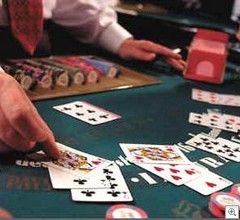 In 1973 Ohioans voted for legalized lottery gambling with a 64 percent majority vote. The active games generate over $2 billion in sales. Net revenues are dedicated to educational programs. Since the 1930s most forms of horseracing (thoroughbred, harness, and quarter horse) have had pari-mutuel betting. Telephone wagering and intertrack simulcast race wagering are permitted and are operational; offtrack betting has been approved. Ohio also has a very active charitable gaming operation with both bingo games and Las Vegas nights.
In 1973 Ohioans voted for legalized lottery gambling with a 64 percent majority vote. The active games generate over $2 billion in sales. Net revenues are dedicated to educational programs. Since the 1930s most forms of horseracing (thoroughbred, harness, and quarter horse) have had pari-mutuel betting. Telephone wagering and intertrack simulcast race wagering are permitted and are operational; offtrack betting has been approved. Ohio also has a very active charitable gaming operation with both bingo games and Las Vegas nights.
Ohio citizens have been a strong market for many gambling operations over history. The Ohio River attracted riverboat gamblers during the nineteenth century, and illegal numbers games and sports betting flourished during the twentieth century. Ohio residents have been the primary player base for illegal casinos in Steubenville and also for northern Kentucky locations such as Newport and Covington. The Mayfield Road Gang ran illegal liquor operations during Prohibition and also established gaming outlets for the Cleveland and Toledo populations. Gang leader Moe Dalitz eventually became one of the founding fathers of the Las Vegas Strip, as he became an owner of the Desert Inn and Stardust in the 1950s.
In the 1990s Ohio became surrounded by new gaming facilities in nearby states and in Canada. Indiana had riverboat casinos just outside of Cincinnati, Casino Windsor and the new Detroit casinos were but an hour’s drive from Toledo, Casino Niagara was within a day’s trip of Cleveland, and West Virginia racetracks had machine gaming within miles of the Ohio border. Ohio also furnished hundreds of thousands of gamblers for Las Vegas and Atlantic City casinos each year.
The encroaching competition for Ohio gaming dollars generated two concerted campaigns for casinos in the Buckeye State during the 1990s. Both campaigns were led by the Spitzer family, who owned a shipyard in Lorain, just twenty miles outside of Cleveland on the shores of Lake Erie. In 1990 they sponsored a petition drive and statewide election to place a casino boat on their lands. They called the casino a pilot project, suggesting that five years later casinos could be placed in other locations. In the 1990 election, 58 percent of the voters rejected the proposals. In 1996 the Spitzers sponsored a petition drive for five casinos, with two on Lake Erie and three on the Ohio River. That year nearly 52% of the Michigan voters said yes to Detroit casinos, but in Ohio 62% of the voters rejected casinos. As more casinos come to rely on Ohio for gambling patrons in the twenty-first century, Ohio interests will no doubt continue to push plans to legalize casinos within their own borders.
|
|